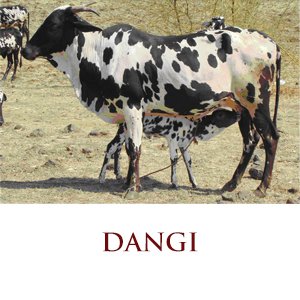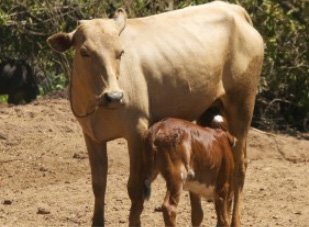Dangi Breed

The Dangi Breed has taken its name from a tract of the country in Gujarat State known as Dangi, which is the home tract of this breed. The breed is considered to be an outcome of breeding between the local and Gir cattle. This tract comprises the hilly and heavy rainfall areas of Ahmednagar, Nasik, Thane of Maharashtra and Dangs and Surat districts of Gujarat. The animals of this breed thrive in heavy rainfall tracts of Western Ghats and in the coastal areas (North Konkan patti) as well where the climate is generally pleasant.
Dangi is a medium-sized, fast-working draught animal. The cattle of this breed are docile and have an energetic and vigorous appearance. The bullocks are utilized for all general agricultural work and are extensively used for paddy cultivation and road transport in the Ghat areas and Konkan patti.
The cows are poor milkers. The average age at first calving varies from 4 to 5 years. The average lactation yield varies from 550 to 680 kg, whereas the well-cared and well-fed cows have yielded up to 1,590 kg.
The cattle of this breed are docile and have an energetic and vigorous appearance. The animals subsist mostly on grazing and on agricultural by-products. These are extremely hardy animals and stand well even under the heavy rainfall conditions.
Characteristics:
- This is a big-boned, low-set, well-built breed with a rather loose skin.
- The color of this breed is black and white in patches.
- The head is usually small with a comparatively large and protruding forehead, with a prominent poll.
- The horns are short and thick, and sometimes like blunt stubs. They spring backwards from their roots, and then upwards and forwards. The fancy breeders train the horns to get a particular shape.
- The eyelids, inside of the ear, switch of the tail, skin surrounding the vulva and teats in females, and scrotum in males are black.
- The eyes are bright, large and deeply set in the sockets with black eyelids. The upper lids have loose skin folds.
- The face is long with slightly loose skin and the muzzle is jet black.
- Neck is usually short and thick with very prominent hump in males.
- Dewlap is thick, pendulous with folds and extends from lower jaw to navel flap.
- Chest is medium, deep and well developed.
- Shoulders are broad and clean set.
- Fore-legs are set well apart, straight and medium in size, with black strong hoofs and a little interdigital space.
- The pasterns are long and sloping.
- The barrel is long, rounded, capacious, and well developed.
- The back is straight but dipping slightly towards the hump.
- The ribs are broad and well sprung.
- The navel flap in both the sexes is long and pendulous.
- The hind-quarters are fairly broad, muscular and well developed.
- The hips are fairly. wide and slightly sloping.
- The thighs are flat and muscular while the inside of the thighs is slightly curved with plenty of room between the legs.
- The buttocks are muscular and angular but not well rounded.
- The tail is of medium length and thick with black switch.
- Legs are well set, placed apart with strong black hoofs.
- The hoof is particularly hard.
- The skin is loose, soft and pliable with glossy hair.
- The udder is medium sized with black teats, which are fairly big. The skin of the udder is black.
- Ears are short, fairly broad and black from inside. Long black hair line the fringe of the ear.
- These are low milk-yielders with the average peak yield of 2.9 liters.
- Height averages at 127 cms. for males and 119 cms. for females.
- Body length averages at 118 cms. for males and 102 cms. for females.
- Body weight averages between 364 to 455 kgs. for males and 270 to 365 kgs. for females.
- Average chest girth is 173 cms. for males and 157 cms. for females.
Help Us Now

Donate to Surabhivana Gaushala to save and protect Indian Cow Breeds.
All donations are exempt under Section 80G of the Income Tax Act, 1961. All donation receipts shall be mailed to the address given by the donor or may be collected in person, at request.
Click the below button to donate through credit cards/debit cards or Net Banking via Razor Pay.
